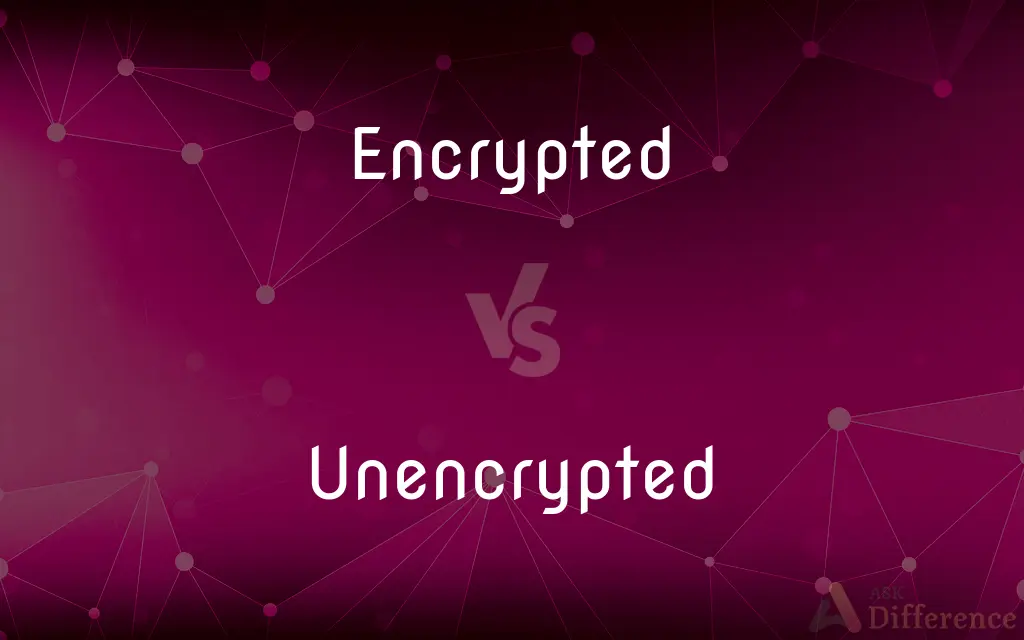Encrypted vs. Unencrypted — What's the Difference?
By Urooj Arif & Fiza Rafique — Updated on March 30, 2024
Encrypted data is transformed into a secure format that requires a key to decode, enhancing privacy and security, while unencrypted data remains in its original, readable form, accessible to anyone.

Difference Between Encrypted and Unencrypted
Table of Contents
ADVERTISEMENT
Key Differences
Encrypted data undergoes a process of encryption, where it is converted from a readable state to an encoded version that can only be accessed or deciphered by authorized parties possessing the correct decryption key. This method is crucial for protecting sensitive information against unauthorized access and ensuring data privacy. On the other hand, unencrypted data, also known as plaintext, does not undergo this process and remains in a format that is easily readable by anyone who accesses it. The lack of encryption makes unencrypted data vulnerable to interception and misuse by unauthorized individuals.
The primary purpose of encryption is to secure digital information, such as emails, messages, and files, by making it inaccessible to anyone without the proper authorization. Unencrypted data, while easily accessible and requiring no additional steps to read or use, poses significant security risks, especially when it contains sensitive or confidential information.
Encryption algorithms play a vital role in the security of encrypted data, employing complex mathematical formulas to transform plaintext into ciphertext. Unencrypted data, however, relies on basic security measures, such as passwords or restricted access, which do not provide the same level of protection against sophisticated cyber threats.
In the context of data transmission over the internet, encrypted data ensures that information remains confidential and tamper-proof from sender to receiver, safeguarding against eavesdropping and data breaches. Conversely, transmitting unencrypted data over the internet exposes it to potential interception by cybercriminals, compromising the integrity and confidentiality of the information.
The decision to encrypt data reflects a commitment to privacy, security, and compliance with regulatory requirements, such as GDPR or HIPAA, which mandate the protection of personal and sensitive information. Unencrypted data, while convenient for less sensitive applications, lacks these protections, making it unsuitable for confidential communications or storing personal information.
ADVERTISEMENT
Comparison Chart
Definition
Data that has been converted into a coded form.
Data in its original, readable form.
Accessibility
Can only be accessed by those with the decryption key.
Accessible by anyone without the need for decryption.
Purpose
Enhances privacy and security of data.
Allows for ease of access and use.
Vulnerability
Protected against unauthorized access and breaches.
Vulnerable to interception and misuse.
Required Technology
Encryption algorithms and keys.
None beyond basic security measures.
Application
Preferred for sensitive or confidential information.
Used for data where security is not a primary concern.
Regulatory Compliance
Often required by laws and regulations.
May not meet standards for protecting sensitive data.
Compare with Definitions
Encrypted
Used to safeguard digital communications.
The company encrypts all data transmissions to ensure privacy.
Unencrypted
Lacks protective encoding against unauthorized access.
Sending unencrypted emails can expose personal information.
Encrypted
Complies with data protection regulations.
Encrypting customer data helps companies comply with GDPR.
Unencrypted
Vulnerable to security breaches.
Storing unencrypted credit card information increases the risk of theft.
Encrypted
Requires a key for decryption and access.
She used a digital key to access the encrypted files.
Unencrypted
Data in its original, accessible format.
Unencrypted text files can be read by anyone with access.
Encrypted
Essential for protecting sensitive information.
Encrypted passwords are harder for cybercriminals to compromise.
Unencrypted
Convenient for non-confidential information.
Public website content is typically unencrypted for easy access.
Encrypted
Data securely encoded to prevent unauthorized access.
Encrypted emails protect sensitive information from hackers.
Unencrypted
Not bound by encryption processes.
Unencrypted data transfers quickly without the need for decryption.
Encrypted
To put into code or cipher.
Unencrypted
(of information or data) not converted into a code that would prevent unauthorized access
Unencrypted passwords
Encrypted
(Computers) To alter (data) using a mathematical algorithm so as to make the data unintelligible to unauthorized users while allowing a user with a key or password to convert the altered data back to its original state.
Unencrypted
(computing) Of something that has been decrypted successfully, or of something that should have been encrypted, but was not.
Encrypted
Being in code; having been encrypted.
The encrypted text was unreadable.
Encrypted
Simple past tense and past participle of encrypt
Encrypted
Converted into a coded form that cannot be interpreted without knowing the secret method for interpretation, called the key; - of messages or other forms of information.
Common Curiosities
What is encrypted data?
Encrypted data is information that has been converted into a secure format, requiring a specific key to decode and access.
Can encrypted data be hacked?
While encryption significantly enhances security, no system is entirely invulnerable; however, breaking encryption requires substantial resources and time.
How does one access encrypted data?
Accessing encrypted data requires the corresponding decryption key or password, which reverses the encryption process to return the data to its original form.
What is unencrypted data?
Unencrypted data, or plaintext, is information in its original form that is readable without the need for decryption.
Why is data encryption important?
Data encryption is crucial for protecting sensitive information from unauthorized access, ensuring privacy, and meeting regulatory compliance.
How can you tell if data is encrypted?
Encrypted data appears as scrambled or unreadable text to those without the decryption key, distinguishing it from readable plaintext.
Is encrypting data a legal requirement?
In many jurisdictions, encrypting certain types of sensitive data is mandated by privacy laws and regulations to protect individual and organizational information.
How is encrypted data different from password-protected data?
Encrypted data is transformed into an unreadable format, while password protection restricts access without altering the data's format. Both can be used together for enhanced security.
What are the disadvantages of encryption?
Encryption can introduce computational overhead and potential performance issues, requiring careful implementation to balance security and efficiency.
Should all data be encrypted?
While encryption is critical for sensitive information, it may not be necessary for all data, depending on its importance and the risk of exposure.
Can unencrypted data be secure?
Unencrypted data relies on other forms of security measures, such as access controls, which can provide a degree of protection but not as comprehensively as encryption.
What happens if you lose the encryption key?
Losing the encryption key can make the encrypted data permanently inaccessible, highlighting the need for secure key management practices.
Are there different types of encryption?
Yes, there are several encryption methods, including symmetric and asymmetric encryption, each with its own use cases and security features.
What impact does encryption have on data transfer speeds?
Encrypting data can slow down transfer speeds due to the additional processing required for encrypting and decrypting data.
Does encryption protect against all cyber threats?
While encryption is a powerful tool for data security, it does not protect against all forms of cyber threats, emphasizing the need for a comprehensive security strategy.
Share Your Discovery

Previous Comparison
Virus vs. Antivirus
Next Comparison
Swamp vs. BogAuthor Spotlight
Written by
Urooj ArifUrooj is a skilled content writer at Ask Difference, known for her exceptional ability to simplify complex topics into engaging and informative content. With a passion for research and a flair for clear, concise writing, she consistently delivers articles that resonate with our diverse audience.
Co-written by
Fiza RafiqueFiza Rafique is a skilled content writer at AskDifference.com, where she meticulously refines and enhances written pieces. Drawing from her vast editorial expertise, Fiza ensures clarity, accuracy, and precision in every article. Passionate about language, she continually seeks to elevate the quality of content for readers worldwide.














































